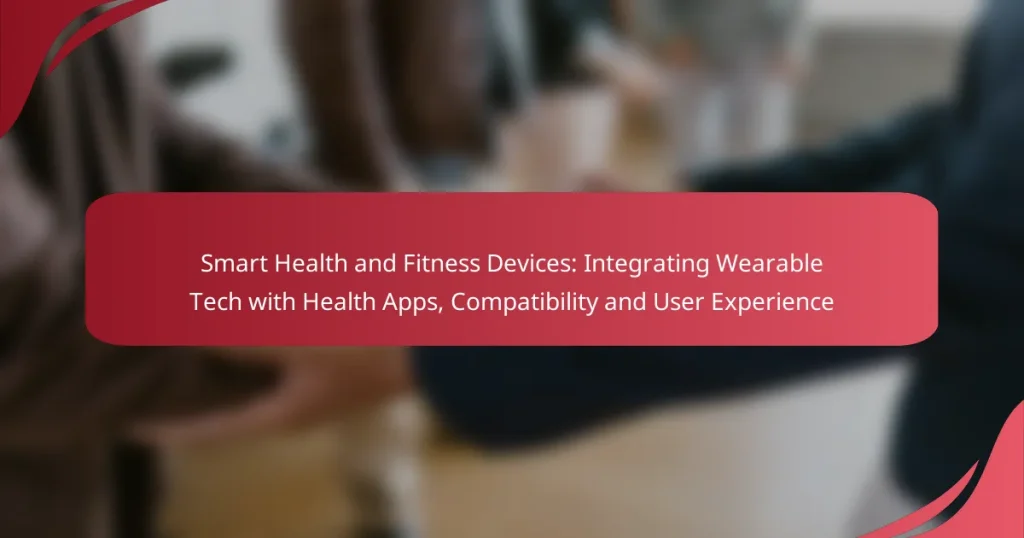Smart health and fitness devices are revolutionizing personal wellness by seamlessly integrating with health apps to provide real-time monitoring of health metrics. This synergy not only enhances user experience but also delivers personalized insights and recommendations tailored to individual fitness goals. With a variety of options available, selecting the right device involves understanding your specific needs and ensuring compatibility with your preferred health applications.

How do smart health and fitness devices integrate with health apps?
Smart health and fitness devices integrate with health apps by using wireless technologies to sync data, allowing users to monitor their health metrics in real-time. This connection enhances the overall user experience by providing personalized insights and recommendations based on collected data.
Wearable devices sync with mobile applications
Wearable devices, such as fitness trackers and smartwatches, typically connect to mobile applications via Bluetooth or Wi-Fi. This synchronization enables users to view their activity levels, heart rate, and sleep patterns on their smartphones, creating a comprehensive health profile.
Most apps support automatic syncing, which means data is updated in real-time without requiring manual input. Users should ensure their devices are compatible with the chosen app to maximize functionality.
Data sharing between devices and apps enhances user experience
Data sharing between wearable devices and health apps enriches the user experience by providing actionable insights. For example, a fitness tracker can share step counts and heart rate data with a nutrition app to suggest calorie intake based on activity levels.
This integration can lead to improved health outcomes, as users receive tailored advice and can track their progress over time. However, users should be mindful of privacy settings to control what data is shared and with whom.
Examples of popular integrations
Several popular integrations exist between smart health devices and apps. For instance, Fitbit devices sync seamlessly with the Fitbit app, allowing users to track workouts, sleep, and nutrition all in one place.
Another example is the Apple Watch, which integrates with the Apple Health app to consolidate data from various health and fitness applications. Users can also connect devices like Garmin wearables with platforms such as Strava for enhanced performance tracking.

What are the best smart health and fitness devices available?
The best smart health and fitness devices combine advanced technology with user-friendly features to track health metrics and enhance fitness routines. Popular options include the Apple Watch Series 8, Fitbit Charge 5, and Garmin Venu 2, each offering unique functionalities and compatibility with various health apps.
Apple Watch Series 8
The Apple Watch Series 8 is renowned for its comprehensive health tracking capabilities, including heart rate monitoring, sleep analysis, and temperature sensing. It seamlessly integrates with the Apple Health app, allowing users to consolidate their health data in one place.
Consider its compatibility with a wide range of third-party fitness apps, which enhances its functionality. The device also supports features like ECG and blood oxygen monitoring, making it suitable for users focused on detailed health insights.
Fitbit Charge 5
The Fitbit Charge 5 is a versatile fitness tracker that emphasizes activity tracking and wellness features. It includes built-in GPS, heart rate monitoring, and stress management tools, making it ideal for fitness enthusiasts who prefer a more streamlined device.
This tracker syncs with the Fitbit app, providing users with personalized insights and goal-setting capabilities. Its battery life typically lasts up to a week, which is advantageous for those who prefer less frequent charging.
Garmin Venu 2
The Garmin Venu 2 is designed for serious athletes, offering advanced metrics such as VO2 max and training load analysis. It features a vibrant AMOLED display and supports a variety of sports modes, catering to diverse fitness interests.
With compatibility with the Garmin Connect app, users can analyze their performance data and join challenges with friends. The device’s long battery life, lasting up to 11 days in smartwatch mode, makes it a practical choice for continuous tracking.

How do I choose the right wearable tech for my needs?
Choosing the right wearable tech involves assessing your specific health and fitness goals, ensuring compatibility with health apps, and considering the device’s features. Start by identifying what you want to track or improve, then match those needs with the appropriate device capabilities.
Consider compatibility with existing health apps
When selecting a wearable device, check its compatibility with health apps you already use. Many wearables sync with popular platforms like Apple Health, Google Fit, or specific fitness apps, enhancing your data tracking and analysis.
Look for devices that support multiple app integrations, as this flexibility allows you to consolidate your health data in one place. Ensure the wearable’s app offers a user-friendly interface and features that align with your health management preferences.
Evaluate features based on fitness goals
Your fitness goals will dictate the features you need in a wearable device. For instance, if you’re focused on running, look for GPS tracking, heart rate monitoring, and pace analysis. Alternatively, if your goal is weight management, consider devices that track calorie intake and expenditure.
Assess additional features like sleep tracking, stress monitoring, and guided workouts, which can provide a comprehensive view of your health. Prioritize devices that offer the most relevant features for your specific objectives to maximize your investment.
Assess battery life and durability
Battery life is a crucial factor when choosing a wearable, as shorter battery life can disrupt your tracking routine. Look for devices that offer at least several days of usage on a single charge, especially if you plan to use them continuously for activities like sleep tracking.
Durability is equally important, particularly for fitness enthusiasts. Choose wearables that are water-resistant or have a rugged design if you plan to use them during intense workouts or outdoor activities. Checking customer reviews can provide insights into real-world performance and longevity.

What are the compatibility factors for smart health devices?
Compatibility factors for smart health devices include operating system requirements, Bluetooth connectivity standards, and supported health app ecosystems. Understanding these elements ensures seamless integration and optimal user experience with wearable technology.
Operating system requirements
Smart health devices typically require specific operating systems to function properly. Most wearables are compatible with popular platforms like iOS and Android, but it’s essential to check the device specifications for compatibility with your smartphone or tablet.
For example, some advanced features may only be available on the latest versions of operating systems. Always ensure your device’s OS is updated to avoid functionality issues.
Bluetooth connectivity standards
Bluetooth standards play a crucial role in the connectivity of smart health devices. Most modern wearables utilize Bluetooth Low Energy (BLE), which allows for efficient battery use while maintaining a stable connection with smartphones and health apps.
When selecting a device, verify that it supports the latest Bluetooth version, as this can enhance connection speed and range. Devices using older standards may experience compatibility issues with newer smartphones.
Supported health app ecosystems
Compatibility with health app ecosystems is vital for maximizing the functionality of smart health devices. Many wearables sync with popular health apps like Apple Health, Google Fit, and Samsung Health, enabling users to track their fitness data effectively.
Before purchasing a device, check which health apps it supports. Some devices may have proprietary apps that offer unique features, while others may limit integration to a few select platforms, impacting your overall user experience.

How do user experiences vary across different devices?
User experiences with smart health and fitness devices can differ significantly based on factors like interface design, usability, and manufacturer support. These elements influence how effectively users can interact with the devices and integrate them with health apps.
Interface design and usability
The interface design of a device plays a crucial role in user experience. Devices with intuitive layouts and easy navigation tend to receive higher satisfaction ratings. For example, a fitness tracker that allows quick access to heart rate data or activity logs can enhance user engagement.
Usability also encompasses the physical design of the device. Wearables that are lightweight and comfortable for all-day wear are generally preferred. Users often favor devices that can be easily customized to fit their personal preferences, such as adjustable straps or customizable display settings.
Customer reviews and feedback
Customer reviews provide valuable insights into user experiences with different devices. Positive feedback often highlights ease of use, accuracy in tracking health metrics, and seamless integration with health apps. Conversely, common complaints may include connectivity issues or lack of features.
Potential buyers should consider aggregating reviews from multiple sources to get a balanced view. Platforms like Amazon or specialized tech review sites can offer a comprehensive look at user satisfaction and device performance across various demographics.
Support and updates from manufacturers
Manufacturer support is essential for maintaining a positive user experience. Regular software updates can improve functionality and fix bugs, which is crucial for devices that rely on accurate data tracking. Brands that provide timely updates and responsive customer service tend to foster greater user loyalty.
Users should check the manufacturer’s track record for support before purchasing. Devices from companies known for their commitment to ongoing improvements and customer assistance are likely to offer a better long-term experience.

What are the emerging trends in wearable health technology?
Emerging trends in wearable health technology focus on enhanced connectivity, improved data accuracy, and user-centric designs. Devices are increasingly integrating with health apps to provide real-time insights and personalized recommendations, making them more effective for users.
Integration of AI for personalized health insights
The integration of artificial intelligence (AI) into wearable health technology allows for the generation of personalized health insights based on individual data. AI algorithms analyze metrics such as heart rate, activity levels, and sleep patterns to offer tailored recommendations that can help users improve their health outcomes.
For instance, a fitness tracker may use AI to suggest optimal workout times based on your previous activity and recovery patterns. This personalization can enhance user engagement and motivation, as users receive actionable insights that resonate with their unique health profiles.
When selecting a wearable device, consider those that offer AI-driven features, as they can provide a more customized experience. Look for devices that continuously learn from your habits and adapt their suggestions over time to maximize their effectiveness.


